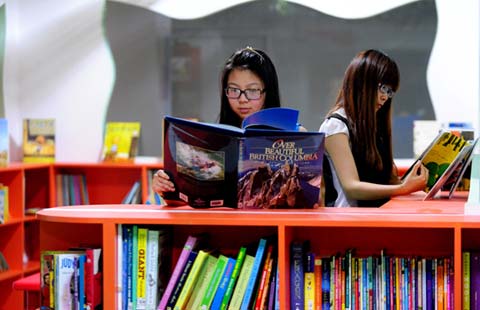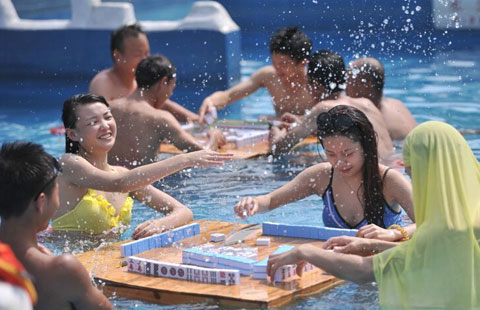News as fast food not a healthy diet
Updated: 2014-07-25 08:44
By David Edwards (China Daily Europe)
|
|||||||||||
Robot-generated content is all very well if data-driven, but there's still no accounting for style
This piece is not being written by a robot, but an increasing number of reports on the Internet are. Recently, a Los Angeles Times writer-bot wrote and posted a story about an earthquake only 3 minutes after it struck, and Associated Press announced that it plans to use automation technology from a company called Automated Insights to produce reports on companies' earnings.
Are we entering an era of automated journalism or is it more of a techno-hype in news production?
Narrative Science, a Chicago start-up specializing in robot writing, takes data from events like sports and crime, and uses algorithms to produce news stories. Indeed, Kristian Hammond, cofounder of Narrative Science, has said that some 90 percent of news could be written by computers by 2030.
So, can anonymous androids really take over from human journalists? What can they do that journalists can't and what will be the limitations of their application?
News bots take the power of database technology and apply it to news gathering. By stitching together data, such as matching statistics or crime figures, with language, they produce news reports.
To achieve this they are programmed with an informational view of the world. In brief, the technology accounts for situations in terms of entities (any relevant thing in a situation about which they gather data), entity attributes (data on entities) and the relationships between them.
Take a very simple example of having coffee. To start with, the entities involved may be a table, a chair, a mug of coffee and a person. All the entities have unique individual attributes such as the type of table, the color of chair and the coffee brand. These are data. Also, the entities are related to each other, for example, the coffee drinker sits on the chair, the coffee mug is placed on the table and the coffee is consumed by the person. Taken together, these data and relationships create information about the coffee shop, and form an informational map that can be used to report on all coffee shops.
News bots employ this idea and are able to use informational templates for standard situations such as sports games or weather reports because they are data driven. The program chooses a template, strings together sentences and data, with perhaps some pre-programmed catch phrases. At the beginning, Narrative Science applied its algorithms to Little League baseball games. Participating parents would enter game statistics into an iPhone app called GameChanger, which churned out written game summaries.
The news bot was born out of the idea of data-driven journalism, which has been gaining momentum for a number of years. Focused on the power of databases to gather and sort large amounts of data, it seeks to liberate our vast subterranean reserve of digital data for the public as "breaking" or "relevant" news.
At the 2008 Future of Journalism conference, sponsored by The Guardian, journalist and computer programmer Adrian Holovaty articulated this vision by saying that there is a crisis in traditional journalism, because newspapers are losing money, there is a lot of bias in news, journalists are inefficiently wasting much of the powerful raw data at the root of their stories.
Holovaty wants news to be more orientated toward computers, and describes story writing as a process of massaging simple facts - such as location, value of goods, victim/s and date for a robbery story - into a large "blob of information" ready for readers' and viewers' consumption.
The problem is that Google or any other search bot has to search through those blobs of stories to pull out those raw data again. News organizations should therefore develop infrastructure linking data networks with agencies (such as environmental agencies in the case of an earthquake story) to gather information, verify and distribute it because, as Holovaty says, journalism primarily involves gathering information, distilling it and presenting it to "consumers". And data infrastructure and databases should be the tool of choice for the job.
So is Hammond's view that by 2030, about 90 percent of news could be written by computers the result of an innovator's enthusiasm, a real possibility or the output of a news bot gone bonkers?
Bot stories are data driven, which is both their strength and weakness. They are great at trawling for data and scooping up relevant information, and they can do it anytime and much faster than any human being. That makes them good at certain kinds of stories that can be captured by standard templates. But with digital news being very porous, standard news articles circulate rapidly and add little journalistic value to a news brand. As the economies of scale increase, journalistic values decrease.
Contrast this with what may be called a story driven approach. A story unravels over time between cycles of interpretation and research, and journalists link situations and interpretations through complex and nuanced relations such as empathy, morality, values, insight and humor, to name but a few. The result is style.
An individual journalist or group of journalists has a style, and so does a publication. In the digital economy, where news now circulates, style is a competitive advantage that differentiates news providers in the vast landscape of online news. Moreover, it is evident that consumers/readers today want style more than ever. On major online news sites, a high quality opinion and comments section is a significant part of the offering. News bots are great for standardized news production, liberating big data and as a journalistic tool, but taken alone they are the journalistic equivalent of fast food. It is doubtful that consumers desire a diet that constitutes 90 percent fast food.
The author is a researcher on journalism with the University of Nottingham, Ningbo, China. The views do not necessarily reflect those of China Daily.
(China Daily European Weekly 07/25/2014 page13)
Today's Top News
TransAsia crash while landing in Taiwan
UK fraud office liaising with China on GSK bribery case
Death toll in Gaza mounts to 701
Meat supplier in global crisis
Dogs 'capable' of feeling jealousy
Five detained over stale meat scandal
5 more universities set up human rights centers
Rebels likely downed jet 'by mistake'
Hot Topics
Lunar probe , China growth forecasts, Emission rules get tougher, China seen through 'colored lens', International board,
Editor's Picks

|

|

|

|

|

|





